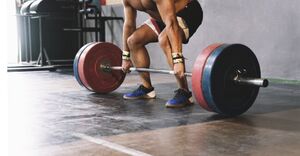
5 Essential Kettlebell Exercises for Beginners: Master the Basics Today
Kettlebell exercises have become increasingly popular in the fitness world, offering a full-body workout that can benefit beginners and seasoned athletes alike.
In this article, we will explore the 5 essential kettlebell exercises for beginners, including the kettlebell swing, goblet squat, Turkish get-up, kettlebell clean and press, and kettlebell deadlift.
We will also discuss the proper form, breathing techniques, and the benefits of mastering these exercises.
Highlighting common mistakes to avoid and providing tips on how to incorporate these exercises into a beginner’s workout routine.
If you’re looking to master the basics and enhance your strength, endurance, and core stability, keep reading to learn more!
What Are Kettlebell Exercises?
Kettlebell exercises are a form of strength training that involves using kettlebells, which are cast-iron or steel weights resembling a cannonball with a handle. These exercises are essential for building muscle strength, improving overall fitness levels, and enhancing muscle endurance and tone.
They target multiple muscle groups simultaneously, engaging both primary and stabilizing muscles, making them an efficient and effective workout choice.
By incorporating kettlebell exercises into your fitness routine, you can enhance functional strength, coordination, and cardiovascular endurance.
The dynamic movements involved in kettlebell exercises also help improve flexibility and balance, contributing to overall physical health and wellness.
Consistent practice of proper kettlebell technique not only aids in muscle development but also reduces the risk of injury by promoting proper body mechanics and alignment.
Why Are Kettlebell Exercises Beneficial for Beginners?
Kettlebell exercises are particularly beneficial for beginners due to their beginner-friendly nature, ability to customize workouts, and the potential for progressive overload to track progress effectively.
These exercises offer a versatile workout routine that can be easily adapted to an individual’s fitness level and goals. The design of kettlebells allows for a wide range of movements, making them suitable for beginners looking to build strength, improve flexibility, and enhance cardiovascular fitness.
The simplicity of kettlebell exercises makes them accessible to those new to fitness, providing a low barrier to entry for anyone wanting to kickstart their fitness journey. As beginners develop proper technique and strength, they can gradually increase the weight of the kettlebell to continue challenging themselves and see positive results in their physical fitness and overall well-being.
What Are the 5 Essential Kettlebell Exercises for Beginners?
For beginners looking to master kettlebell exercises, starting with these five essential movements is key to building a strong foundation. Mastering these exercises involves understanding the proper form, gripping techniques, and mastering the required number of repetitions to perfect each movement.
- The first essential exercise for beginners is the kettlebell swing, which targets the posterior chain and helps develop explosive power.
- Next, the goblet squat is crucial for building lower body strength and improving mobility.
- Moving on to the Turkish get-up, this exercise enhances core stability and overall body coordination.
- The kettlebell clean and press is effective for upper body strength and shoulder stability.
- The single-arm kettlebell row helps in improving back strength and grip power.
By focusing on mastering these fundamental movements with proper form and repetitions, beginners can lay a solid groundwork for their kettlebell training journey.
Kettlebell Swing
The kettlebell swing is a dynamic exercise that targets multiple muscle groups, primarily focusing on the posterior chain, including the glutes, hamstrings, and core muscles. It requires proper technique, core engagement, balance, and flexibility to perform effectively.
Engaging the core muscles is crucial in maintaining stability throughout the movement. As you swing the kettlebell, the core acts as a stabilizer, preventing excessive arching of the lower back.
This exercise also enhances balance by requiring coordination between the upper and lower body. The swinging motion promotes flexibility in the hip flexors and hamstrings, aiding in overall mobility.
Regular practice of kettlebell swings not only strengthens the core but also improves posture and assists in injury prevention.
Goblet Squat
The goblet squat is a fundamental kettlebell exercise that targets the lower body, specifically the quadriceps, glutes, and hamstrings. Proper form, correct posture, and lower body strength are essential for mastering this exercise and reaping its benefits.
Maintaining a straight back, engaging the core, and keeping the knees aligned with the toes are crucial aspects of performing the goblet squat correctly. Focusing on maintaining a controlled descent and explosive drive on the way up helps maximize the engagement of the leg muscles.
This exercise not only builds lower body strength but also enhances overall functional movement patterns. By incorporating goblet squats into your strength training routine, you can improve your leg strength, promote proper posture, and prevent injury.
Turkish Get-Up
The Turkish get-up is a complex kettlebell exercise that enhances shoulder stability, coordination, and overall body awareness. Mastering the technique and progressing gradually is crucial to prevent injury and maximize the benefits of this exercise.
This exercise involves a series of movements that require precise shoulder engagement to support the weight overhead. Proper coordination is essential as you transition from lying down to standing up while maintaining control throughout. By focusing on the progression of weight and repetitions, individuals can build strength while reducing the risk of strain or overuse injuries.
Each step of the Turkish get-up should be executed with attention to detail and a mindful approach to ensure safe and effective implementation.
Kettlebell Clean and Press
The kettlebell clean and press exercise is a compound movement that targets multiple muscle groups, including the arms, shoulders, and core. It requires proper form, core engagement, and specific goals to achieve optimal results.
Proper form is crucial in executing the kettlebell clean and press effectively; a slight deviation can lead to strain or injury. Focus on keeping your back straight, engaging your core to stabilize the movement, and ensuring a smooth transition between the clean and the press.
Developing arm strength is key to mastering this exercise, as it demands controlled movements that engage the biceps, triceps, and shoulders. By setting clear goals, like increasing the weight lifted or the number of repetitions, progress can be tracked and performance improved over time.
Kettlebell Deadlift
The kettlebell deadlift is a fundamental strength-building exercise that targets the posterior chain, including the lower back, glutes, and hamstrings. Performing the correct number of repetitions, engaging the right muscles, and understanding the advantages of this exercise are crucial for optimal results.
Repetitions play a key role in kettlebell deadlifts as they help in building endurance and muscle strength. By consistently performing sets of deadlifts with proper form, individuals can effectively challenge their muscles and promote growth. Engaging the targeted muscles, such as the glutes and hamstrings, not only enhances strength but also improves stability and balance.
The advantages of kettlebell deadlifts extend beyond muscle development; they also help in enhancing overall functional fitness, posture, and even aiding in injury prevention by strengthening the core and supporting muscles.
How to Perform These Exercises Correctly?
Executing kettlebell exercises correctly involves mastering the technique, maintaining proper form, utilizing appropriate breathing techniques, and following essential safety tips to prevent injuries.
- Proper execution of kettlebell exercises starts by engaging your core muscles to stabilize your body throughout the movements. It is crucial to maintain a firm grip on the kettlebell handle and keep your wrists straight to prevent strain.
- When performing swinging motions, ensure that your arms are energized but relaxed, allowing the momentum to come from your hips rather than your arms. Focus on your breathing, inhaling deeply during the eccentric phase and exhaling forcefully during the concentric phase.
- Remember to start with a lighter weight to perfect your form before advancing to heavier kettlebells.
Proper Form and Technique
Proper form and technique are crucial for maximizing the effectiveness of kettlebell exercises, ensuring correct gripping, engaging core muscles, and avoiding common mistakes that can hinder progress.
When it comes to gripping the kettlebell, it’s essential to maintain a firm yet comfortable hold to prevent slips or potential injuries. Alongside gripping, engaging your core is fundamental to stabilize your body during dynamic movements like swings or presses. By consciously activating your core, you not only enhance the effectiveness of the exercise but also protect your lower back from strain. Being mindful of common mistakes such as relying too much on momentum rather than muscle strength or compromising form under fatigue can help you progress steadily and safely in your kettlebell training.
Breathing Techniques
Implementing appropriate breathing techniques during kettlebell exercises enhances coordination, improves workout efficiency, and aids in preventing injury. Incorporating proper breathing patterns into warm-up and cool-down routines is essential for overall well-being.
Maintaining a consistent breathing rhythm in sync with the movements of kettlebell exercises not only helps in maximizing your performance but also ensures that your muscles receive an adequate supply of oxygen. Proper breathing techniques serve as a natural way to regulate your heart rate, keeping it steady and aiding in maintaining focus throughout your workout session.
By incorporating diaphragmatic breathing into your warm-up routine, you prepare your body for the upcoming physical activity, gradually increasing blood flow to your muscles and enhancing flexibility. Likewise, during the cool-down phase, controlled breathing can assist in promoting relaxation and aiding the body in returning to its resting state, facilitating recovery and reducing muscle soreness.
What Are the Benefits of Mastering These Kettlebell Exercises?
Mastering kettlebell exercises offers numerous benefits, including:
- Improved strength and endurance
- Enhanced core stability
- Full-body workouts
- Increased flexibility
- The ability to track progress and achieve new fitness goals effectively
Once you understand the proper technique and form for kettlebell exercises, you can experience a significant increase in muscle tone and overall body composition. The beauty of kettlebell training lies in its versatility, allowing you to perform a wide range of dynamic movements that engage multiple muscle groups simultaneously. Mastering kettlebell exercises can lead to improved posture, injury prevention, and heightened cardiovascular conditioning. By incorporating kettlebell workouts into your fitness routine, you can continuously challenge yourself, set new personal records, and witness extraordinary physical transformations over time.
Full Body Workout
Kettlebell exercises provide a comprehensive full-body workout that targets multiple muscle groups simultaneously, enhances cardiovascular endurance, and presents unique challenges to improve overall physical fitness.
By incorporating kettlebell exercises into your routine, you engage various muscle groups such as the core, shoulders, back, and legs in dynamic movements that require coordination and stability. These exercises not only help in building strength but also boost cardiovascular fitness through high-intensity intervals that elevate heart rate and improve endurance. The challenges posed by kettlebell workouts, like mastering proper form and progressing to heavier weights, promote continuous growth and development, making them an effective tool for enhancing overall physical performance and fitness levels.
Improved Strength and Endurance
Mastering kettlebell exercises leads to improved strength and endurance in key muscle groups, including the core, arms, legs, and shoulders, enabling individuals to perform daily tasks with greater ease and efficiency.
By incorporating kettlebell exercises into a regular fitness routine, individuals can experience significant enhancements in their overall physical capabilities. The dynamic nature of kettlebell movements not only targets specific muscle groups but also enhances coordination and stability.
This functional strength gained through kettlebell training translates into real-world benefits, such as improved posture, better balance, and increased stamina for activities like lifting groceries, climbing stairs, or playing sports.
Through consistent practice, individuals can build resilience in their core, arms, and legs, which are pivotal for maintaining a healthy and active lifestyle.
Increased Core Stability
Developing core stability through kettlebell exercises promotes better balance, overall health, and well-being, as a strong core is essential for maintaining proper posture, preventing injuries, and supporting daily movements.
By engaging in kettlebell exercises that target the core muscles, individuals can significantly enhance their balance, which translates to improved stability in various activities and reduced risk of falls. This improved balance not only contributes to physical well-being but also boosts confidence in everyday movements.
Strengthening the core through kettlebell workouts also leads to better alignment of the spine, reducing strain on the back and enhancing overall health. The benefits of a stable core extend beyond physical appearance, as they play a vital role in optimizing functionality and vitality.
Enhanced Functional Movements
By mastering kettlebell exercises, individuals can enhance their functional movements, refine their technique, improve balance, and explore modifications to tailor workouts to their specific needs and abilities.
Functional movements encompass daily activities that require different muscle groups to coordinate efficiently. The technique refinement involved in kettlebell exercises helps individuals perform these movements with proper form and reduces the risk of injury. Improved balance is another crucial benefit, as kettlebell workouts challenge stability and core strength. By incorporating modifications, such as varying weights or adjusting the range of motion, individuals can customize their workouts to suit their fitness levels and target specific areas for improvement.
Time Efficient Workouts
Kettlebell exercises offer time-efficient workout solutions that can be integrated into daily routines, enabling progress tracking, personalized training sessions, and flexibility in scheduling with or without a personal trainer.
The beauty of incorporating kettlebell exercises into your routine lies in their versatility and effectiveness. By engaging in these workouts, you have the opportunity to constantly monitor your progress, making adjustments where needed. Whether you prefer a structured routine or a more flexible approach, kettlebell exercises can cater to your individual preferences. Personal trainers can play a crucial role in guiding you through proper technique and helping you achieve your fitness goals.
What Are Some Common Mistakes to Avoid?
To optimize the benefits of kettlebell exercises, it is crucial to avoid common mistakes that may hinder progress, address frequently asked questions, and understand the advantages and disadvantages associated with this form of training.
One common mistake to avoid during kettlebell exercises is using improper form, which can lead to injury. It’s important to maintain proper alignment, engage core muscles, and avoid swinging the weight uncontrollably.
Another mistake is using a weight that is too heavy, leading to strain and potential injury. Ensure you start with a weight that allows you to maintain good form throughout the exercises.
Addressing common questions, many people wonder about the effectiveness of kettlebell training for weight loss. The key is to combine kettlebell workouts with a balanced diet for optimal results.
When it comes to advantages, kettlebell exercises are efficient for building strength and improving cardiovascular fitness. On the other hand, a disadvantage of this training method is the potential for overuse injuries if not done correctly. By following proper techniques and listening to your body, you can maximize the benefits while minimizing the risks.
Using Too Much Weight
One common mistake to avoid in kettlebell exercises is using too much weight, which can compromise technique, hinder progression, and potentially lead to the need for corrective exercises to address form and stability issues.
Proper technique is crucial when engaging in kettlebell exercises to avoid unnecessary strain on the body. Gradual progression allows the muscles and joints to adapt and strengthen over time, reducing the risk of injury. In cases where form and stability concerns arise, implementing corrective exercises can help retrain muscles and improve overall movement patterns. It is essential to prioritize safety and precision in each kettlebell workout to maximize the benefits and minimize the chances of setbacks due to improper weight usage.
Not Engaging Core Muscles
Failing to engage the core muscles properly during kettlebell exercises can lead to poor form, compromised posture, increased challenges in completing movements, and potential mistakes that may hinder progress and increase the risk of injury.
Strong core engagement not only enhances stability but also aids in transferring power effectively throughout the body when using kettlebells. By maintaining proper form through core activation, individuals can optimize their workouts, target specific muscle groups, and prevent unnecessary strain on joints.
A stable core minimizes the risk of injury by supporting the spine and promoting better body alignment during dynamic movements. Focus on core engagement is fundamental in kettlebell training for maximizing results and preventing setbacks.
Incorrect Breathing Techniques
Incorrect breathing techniques during kettlebell exercises can impact performance, hinder warm-up and cool-down effectiveness, disrupt progression, and limit the overall benefits derived from the workout routine.
When you do not breathe properly while performing kettlebell exercises, your body may not receive sufficient oxygen, leading to fatigue and reduced stamina. This can make it challenging to maintain proper form, resulting in potential injuries. Inadequate breathing can prevent your muscles from getting the necessary blood flow, hindering their ability to recover during the cool-down phase. As a result, your overall progression may suffer, and you might not see the desired improvements in strength and endurance that you are striving for.
Not Progressing to Heavier Weights
Failing to progress to heavier weights in kettlebell exercises can limit strength gains, hinder balance development, impact overall health benefits, reduce flexibility, and prevent the exploration of modifications to challenge and adapt the workout routine.
If individuals stick to the same weight for an extended period, they risk plateauing in their strength gains, missing out on the opportunity to continually challenge their muscles for growth.
This stunted progress not only affects their physical strength but also impedes the enhancement of balance, as increasing weight forces the body to stabilize and coordinate movements effectively.
Without advancing to heavier kettlebells, the potential health outcomes, such as improved cardiovascular health and muscle tone, may not be fully realized.
Neglecting to modify the routine can lead to boredom and decreased motivation, hindering overall performance optimization.
How to Incorporate These Exercises into a Beginner’s Workout Routine?
Incorporating kettlebell exercises into a beginner’s workout routine involves providing clear instructions, offering demonstrations for each exercise, and utilizing video tutorials to ensure proper form and technique execution.
When beginning a kettlebell workout routine, it’s important to start with lighter weights to get comfortable with the movements and prevent injuries. Focus on mastering basic exercises like swings, squats, and presses before progressing to more complex moves. Seek out beginner-friendly resources that provide step-by-step guidance on proper kettlebell techniques.
Demonstrations can help you visualize how each exercise should be performed, ensuring you’re following the correct form. Video tutorials are especially helpful for beginners, as they offer a visual guide to executing kettlebell exercises safely and effectively.




No Comments